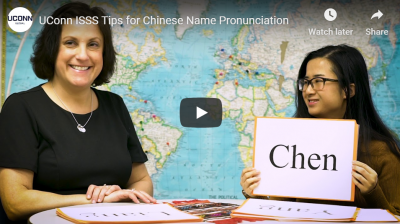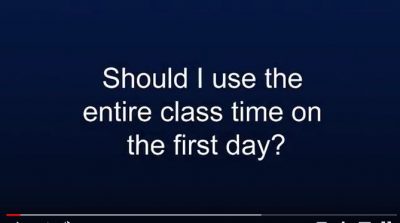The first day of class is important because it provides the preview for the course. It affords you an opportunity to introduce yourself and your course design, gain a better sense of your students are, their backgrounds and aspirations, communicate expectations, and establish the culture (tone and tenor) for the semester. Critically important, it also provides students with an opportunity to get a glimpse of your teaching style, course timelines and milestones, and your overall expectations for learning success. Carefully plan the first class session so you are sure to cover everything intended and set the impression you want to maintain as the semester continues.
Remember. . .
- Students don't care what you know until they know that you care (find ways to convey during the first class that you care about their learning and success)
- First impressions are lasting so make the most of the first day
- Success is dependent upon your intentionality and planning. Your efforts will pay off with a more satisfying first day for your students, which in turn, will set the tone for the entire semester.
Plan your first day objectives
Prepare to meet your needs and the needs of your students by planning ahead:
Creating a positive first impression: They say it takes 1/10th of a second for people to form a first impression of others. Here are three things you can do to create a strong first impression on the first day of class:
- Introducing yourself: At the beginning of the first class, introduce yourself in a friendly and approachable manner and to establish your chosen level of formality and familiarity---be sure to tell students what to call you (Professor, Doctor, Joe) and decide whether to tell them anything about yourself. Maintaining eye contact with students and demonstrating other positive non-verbal behaviors can help in establishing a positive first impression.
- Introducing your course: Demonstrating genuine enthusiasm for your course is perhaps the single most important factor in creating a positive first day climate in the classroom. After all, if you aren't excited about the history, discoveries, impacts, and questions in your field, why should others? In addition, students often need basic course information to determine if the course is right for them; the sooner students understand course expectations, the more informed they’ll be to make speedy schedule changes, if necessary, within the add/drop time frame. You should give a course content overview (or even a mini-lecture) that provides a broad look at the subject. This gives students an idea of what to expect from the content of the course. Note: While the default date for HuskyCT course sites to open is midnight before the first day of the semester, many faculty choose to open/provide access to students sooner and/or send their syllabus to their class roster via email a week or two before the semester begins.
- Getting to know your students: You can also start connecting with students by helping to make them feel welcome and that they belong. Students typically have many questions about how the class will meet their needs and its import to their chosen academic pathway/major. You should strive to establish a give-and-take atmosphere the first day by asking questions of the students. Give students a chance to ask questions and begin to make their own connections so they will be more at ease and likely to stay engaged in subsequent class sessions. It is also critically important to exert the effort required to properly pronounce, learn, and retain student preferred names.
- Calling a person by their preferred name demonstrates respect. Using students’ preferred names contributes to the University’s goal of providing an inclusive, safe, and nondiscriminatory environment. Names are extremely important parts of a person’s identity. Most names and pronouns are gendered. The use of preferred names provides students with an opportunity to be referred to in a manner more consistent with their gender expression. For additional guidance see the Rainbow Center's Gender and Pronoun Guide.
- Equally important is learning how to properly pronounce student names. While mispronouncing a student’s name may seem minor, it can have a significant impact on how they see themselves and their cultural background, causing feelings of anxiety, invisibility, shame, resentment and humiliation, all of which can lead to social and educational disengagement. While mispronouncing a student's name can adversely impact their level of motivation and engagement, correctly pronouncing a student's name can help develop trust and rapport. Here are some strategies faculty can use to learn, retain, and pronounce student names.
- Use the first class as an opportunity for students to individually introduce themselves to you and their classmates. In addition to their (preferred) name and its pronunciation, you can ask them to share additional things such as major, career aspiration, and motivation for taking this class.
- Consider using Flipgrid as a means for students to introduce themselves visually and virtually to you and their classmates. Instructions on how to get started with Flipgrid can be found here and faculty with questions and/or in need of support can reach out to CETL Ed Tech.
- Utilize student photos in Student Admin to provide a facial visual cue to help match students with their names. Note this is more easily accomplished in remote synchronous classes than in-person classes with students wearing face coverings.
- With smaller classes, faculty can invite and then schedule brief appointments with all students in the course during virtual office hours over Webex or Teams.
- With larger classes, faculty can break the class into smaller student groups for learning activities over the first few classes, and then visit each group, practicing and learning names in chunks.
- With larger classes, faculty can use name tents combined with encouraging students to sit in the same general vicinity each time they attend class.
- With larger classes that have lab and discussion sections, faculty should make sure that TA's make every effort to learn, retain, and properly pronounce student preferred names.
- Make a point of memorizing just a few names and faces before each class and call on them during class---over the course of the semester attempt to reach every student.
- Make a point of asking students to share their name when responding and try to use their name when answering or referring back to them.
See also: The Importance of Learning Student Names (Tamara Glenz, Journal on Best Teaching Practices, April 2014) and How we Pronounce Student Names and Why it Matters (Jennifer Gonzalez, April 2014)
Why and how to learn student names??
Although it takes effort on your part, learning your students’ names can prove beneficial in creating the classroom environment you desire. By knowing student names, the course is more organized, has increased discussion, and has increased student-instructor rapport and trust.
Techniques:
- Utilized pictures from the Student Administration System (PeopleSoft)
- Have required visits to your office to pick up assignments or test results
- Ask students their name when they raise their hand
- Have students hand in exams to you when completed or assignments as they walk in door and look at the name then greet them by name
- While students are working in groups, circulate the room to learn names in these groups
- Utilize ice breakers, particularly those that allow you to link name to something or someone you can easily remember (funny fact, superhero, favorite author)
- Many students sit in the same seats for every session so create a seating chart
- Quiz yourself on student names while you are proctoring an exam or during group work
Ice Breakers Ideas
Individual or Paired Activities
- Introductions. Have students interview each other with a list of pre-developed questions and then introduce their partners to the class.
Small Group Activities
- Ask the Instructor. In groups of 3-4 students, have the students introduce themselves to each other, develop a question they would like the instructor to answer, and then write the question on a note card. Collect the note cards and answer each question.
- Common Ground. In small groups, have students come up with six things that they all have in common, then have each group share their lists with the rest of the class.
- Venn Diagram. In groups of 3-4 students, give each group a large sheet of paper and a different color marker for each person, then have them draw a Venn diagram with an oval for each student. The students in each group should diagram their similarities and differences.
Whole Class Activities
- Assumptions and myths. Have students discuss assumptions and myths about the content area or about college courses.
- Five-Fingers. Have each student give the following information using the five fingers on his/her/their hand as a prompt:
- Thumb – name something you’re good at
- Pointer – state your career goal
- Middle – tell the others something that makes you mad
- Ring – name someone or something special to you
- Pinky – state something to remember you by
- People Bingo. Do a variation of a scavenger hunt by giving students a sheet of paper with a list of activities (e.g., has studied another language, grew up in another state, born in another country, majoring in biology, has performed before an audience of at least 100, has already bought the text for this course, has 4 or more siblings). Have them match other students in the class to the activities or facts listed. Students should sign their name by the activity or fact that applies to them but each student’s name can only appear once on the sheet. The first student to fill in all the blanks or the one who has the most blanks filled in after 10-15 minutes wins.
- How do you feel? Ask the students to write down words or phrases that describe their feelings on the first day of class on the blackboard, then ask them to write down what they think you as the teacher are feeling this first day of class. Note the parallels and briefly comment on your feelings.
- Two True, One False. Go around the class and everyone has to say two true statements about themselves and one false. The rest of the group has to guess which one is false.
Breaking the ice: Consider using “ice breakers” to ease some of the first-day awkwardness. Ice breaker activities can help students and faculty get acquainted and establish classroom community on the first day of class, along with helping students begin to develop a support network for the class. See the list of ice breaker ideas below.
Reviewing syllabus: Consider handing out the syllabus or, if it is online, bringing it up on the overhead and reading through it with the students. This may be the only time they go over it. Highlight your course’s student learning outcomes or objectives and expectations for class behavior. Explain why you chose your textbook and readings, discussing how they relate to each other and to the course content. Students typically look to the syllabus for due dates, but they may not look at the rest beyond this first opportunity. Emphasize that the syllabus is a “contract” between the instructor and the students.
Starting on course material: Depending on how long the class session lasts and all that you want to accomplish beyond housekeeping, you will need to decide on what you want to accomplish but at least part of the first session should deal with content. As part of the course overview, you can whet their appetite with video segments or provide a concept map of how the course fits together. You can help students start making connection with their prior knowledge and how it will be expanded in your course. Plan this portion carefully because it could leave a poor impression if, on the first day, you already are unable to cover all the material that you planned.
Ending the first session: At the end of the first session, you should take a few moments to allows students to reflect utilizing techniques such as a minute paper. You can also reassure students since some amount of cognitive dissonance or even a state of panic can occur following the first session.
Tips:
- Visit the classroom before the first class session. Sit in various areas of the room, including the last row. Are you able to see the screen, white board, or monitors from all areas?
- Be enthusiastic. Be there early to talk to students. Greet each student upon his/her entrance. Stay late to talk to students.
- Debrief any icebreaker activities you use. Talk with students about why you spent class doing it, ensuring they understand their fellow students can be valuable resources. Ask for student opinions on the use of icebreakers and what they learned.
Additional resources:
Brent, R. & Felder, M. (1999). It’s a start. College Teaching, 47(1), 14-17.
Davis, B. G. (2009). Tools for teaching (2nd ed.). San Francisco: Jossey-Bass.
Erickson, B., Peters, C.B., & Strommer, D.W. (2006). Teaching first year college students. San Francisco: Jossey-Bass.
Lyons, R.E., Ksilka, M.L., & Pawlas, G.E. (1999). The adjunct professor’s guide to success. Needham Heights, MA: Allyn & Bacon.
McGlynn, A.P. (2001). Successful beginnings for college teaching: Engaging your students from the first day of class. Madison, WI: Atwood Publishing.
Meyers, S., & Smith, B. (2011). The first day of class. To Improve the Academy (Judith E. Miller & James E. Groccia, Eds), 29, 147-159.
Silberman, M.L. (1996). Active learning. Needham Heights, MA: Allyn & Bacon.
Smith, G. (September, 2008). First-day questions for the learner-centered classroom. The National Teaching& Learning Forum, 17(5), 1-4.
Svinicki, M. & McKeachie, W. J. (2010) McKeachie's teaching tips : Strategies, research, and theory for college and university teachers. (13th ed.). Belmont, CA: Wadsworth.
20-Minute Mentor Tips
Thanks to our institution subscription to 20-Minute Mentor you have countless teaching tip videos available at the click of a button. Here are a few related to this topic:
How can student learning begin before the first day of class?
How can I capture students’ interest in the first 5 minutes?
If you have not signed up for your subaccount, here is how: http://cetl.uconn.edu/20-minute-mentor-commons-subscription/
Quick Links
![]()
Consult with our CETL Professionals
Consultation services are available to all UConn faculty at all campuses at no charge.



